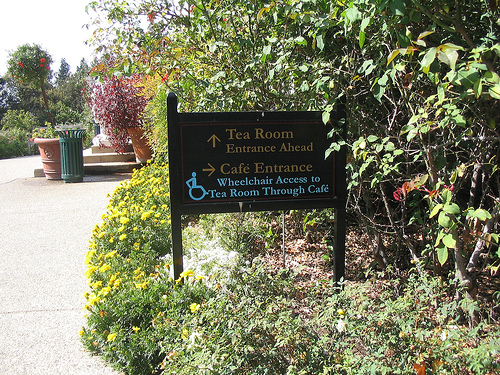In this video the always-fantastic Jay Smooth, of Ill Doctrine, spends just over four minutes offering his perspective on the Occupy Wall Street movement. He likes it. And, he says, more importantly, the media coverage and treatment of the protests is telling us a lot about who’s in bed with who, politically speaking.
Lisa Wade, PhD is an Associate Professor at Tulane University. She is the author of American Hookup, a book about college sexual culture; a textbook about gender; and a forthcoming introductory text: Terrible Magnificent Sociology. You can follow her on Twitter and Instagram.The Hall of Fame
- American Able: Challenging Depictions of People with Disabilities (pictured)
- Resistance to Objectifying Advertising
- Imaging Barbie’s Fantastic Proportions
- Dark Girls: Race, Beauty, and Bias
- Race and the Problem with Measuring Beauty Objectively
- Indian Americans Respond to Skin Whitening
- Kids Thoughts about Skin Color and Beauty
- Glamour Uses “Plus-Sized” Models, and People Love It!
- Men’s and Women’s Ideal Female Bodies
- Men Are Allowed to Grow Up
- Reclaiming the “Before” Body (NSFW)
- How Vulvas Vary (NSFW)
- Normalizing Normal Breasts (NSFW)
- Rebellyon
The Hall of Shame
- (Hairy) Ball Bashing
- 1950s Beauty Pageant Judging Guidelines
- Gingerism
- Lightness as Symbolic Capital: Fair Skin in Marital Ads
- Multinational Corporations and the Cultivation of Colorism
- Novels About Non-Thin Women Put Thin Women on their Covers
- Your Hairy Legs Could Be Mass Murderers Even Now
- “Normal” vs “Abnormal” Hair and Skin
- How To Undermine a Body-Acceptance Message
- From K-Fed to K-Fat: Policing the Bodies of Male Celebrities
- The Jennifer Love Hewitt Bikini Controversy
- Keeping “It” Lady-Like: Avoiding Camel Toe
- How Ratings Boards are Driving Genital Cosmetic Surgery
- Zappos: Fits For Every Body Type… or Something
- The Hierarchy of Race and Size in a Dove Ad
- Media Depictions of Trans-People as Bodies Only
- An Entitlement to Female Beauty: Criticism of Female Body Builders
- Apparently We Need to Dye Women’s Genitals Pinker
- How Not to Personify the Opposing Team
I am re-posting this fun counterfactual in honor of October 19th Love Your Body Day. Crossposted at Jezebel.

I was thinking the other day about fashion advice for women with different body types. The advice is almost always aimed at getting women’s bodies, whatever shape they might be, to conform with one ideal body type: the (skinny) hourglass figure. The advice video below, sent in by Tara C. and aimed at women with “pear-shaped” bodies, does exactly this (excerpts and commentary after the clip):
So, the advice, as I mentioned, is all about trying to hide the shape of her actual body and make it appear to be more hourglass. To “transform it into an hourglass,” they say:
- “slim your hips and thighs”
- “draw attention to the upper part of your body”
- “balance your figure” with shoulder pads
- “a roomy top will de-emphasize your bottom”
- “offset your hips”
- “avoid side pockets, they add bulk where you least need it”
I wonder what it would be like to live in a world where the fashion industry encouraged us to “emphasize” our differences from one another, instead of trying to make us all look the same. If you were pear-shaped, for example, the advice would be all about highlighting that awesome booty and tiny waist and shoulders. Work that pear-shape!
If you were broad-shouldered and thin-hipped, the advice could all be aimed at broadening your shoulders (shoulder pads and fancy necklines) and thinning your hips (dark colors and no pockets)! Work that triangle-shape!
If you were apple-shaped, advice would be aimed at looking rounder with even skinner arms and legs. Work that apple-shape!
If you were petite, advice could be aimed at looking smaller; if you were tall, advice could be aimed at looking larger.
If you had short legs, advice would tell you how to elongate your torso; if you had long legs, advice would tell you how to shorten it.
I think this would be a super fun world to live in.
Title slide image from Lemon Drop Clothing.
Lisa Wade, PhD is an Associate Professor at Tulane University. She is the author of American Hookup, a book about college sexual culture; a textbook about gender; and a forthcoming introductory text: Terrible Magnificent Sociology. You can follow her on Twitter and Instagram.Re-posted in honor of Love Your Body Day.
This symbol is the international symbol for persons with disabilities:

It looks pretty straightforward. Descriptive even.
But check out this symbol that I saw at a T.J. Maxx in California:

Notice how the second symbol represents people with disabilities as active and independent. There are motion signs and the figure is pushing its own chair.
The comparison reveals how much the first represents them as passive and helpless.
UPDATE! In the comments thread, Penny added a link to the symbol they use at the Huntington Library (Pasadena, CA):

For more posts on symbology, see our posts on traffic lights with female figures, stick figures and stick figures who parent, and default avatars.
Lisa Wade, PhD is an Associate Professor at Tulane University. She is the author of American Hookup, a book about college sexual culture; a textbook about gender; and a forthcoming introductory text: Terrible Magnificent Sociology. You can follow her on Twitter and Instagram.
A post for Love Your Body Day.
Krista, Debbie, and Diego sent in the following commercial for FreeScore. It nicely illustrates our bias against men who don’t live up to idealized standards of masculinity. That is, men who are short, bald, and soft.
Like a bad credit score, men who aren’t young and handsome are a total drag. Klutzy, a potential serial killer, afraid to stand up for himself… his pain is our last laugh. Disgusting.
Lisa Wade, PhD is an Associate Professor at Tulane University. She is the author of American Hookup, a book about college sexual culture; a textbook about gender; and a forthcoming introductory text: Terrible Magnificent Sociology. You can follow her on Twitter and Instagram.If you’re not (or not yet) an academic, this cartoon may not make much sense to you. But if you are…
 (cartoon by Nearing Zero; via Philip Cohen)
(cartoon by Nearing Zero; via Philip Cohen)
For the uninitiated:
To get a paper published in an academic journal, scholars have to submit a draft to a journal and wait up to a year for feedback that is, not-uncommonly, rather brutal. This is because writing a journal article is difficult and our colleagues are rather smart. And busy. So there’s no time for hand-holding.
Decisions are usually “reject” (we never want to see this paper again as long as we live) or “revise-and-resubmit” (right now this paper sucks, but if you spend another six months of your life working on it, there is some possibility that we might publish it… maybe… but for now it’s important that you understand that it really sucks).
It’s typical to have to submit a paper to two or three journals before it’s finally accepted. And it’s not unheard of to have to submit it to five or six. So… yeah, it can feel like being beaten, repeatedly. For sure.
I’ll take harrowing publication stories in the comments, if you’ve got ’em!
Lisa Wade, PhD is an Associate Professor at Tulane University. She is the author of American Hookup, a book about college sexual culture; a textbook about gender; and a forthcoming introductory text: Terrible Magnificent Sociology. You can follow her on Twitter and Instagram.
Time Magazine (2009) reports that McDonald’s has approximately 32,000 restaurants in 118 countries. Of those, only about 45% were in the United States. The key to success of the American restaurant chain in other countries is to adapt its business to the local culture.
For example, today McDonald’s operates approximately 1,000 restaurants in China. In the book McDonald’s: Behind The Arches, Yunxiang Yun argues that it has been successful in Beijing because it has become a fun place to hang out. While it seems foreign to many Westerners, who think of McDonald’s as a place to buy cheap food quickly, many Chinese people eat there because of the atmosphere and service. More, the food isn’t associated with obesity, as it is in the U.S.
This perception of McDonald’s has made it a sought out location for weddings. Er, McWeddings.
A McDonald’s nuptial package in Hong Kong costs about HK$10,000 (US$1,300). According to the New York Times, a McWedding…
…includes food and drinks for 50 people… a “cake” made of stacked apple pies, gifts for the guests and invitation cards, each with a wedding photo of the couple.
The ability to reinvent itself is the key to the Golden Arches’ success in China. It also suggests that the associations Americans have with the chain aren’t inevitable, but specific to cultural context. Projected to double the number of stores by 2013, it will be interesting to see what other adjustments McDonald’s makes down the road.
Sangyoub Park is an assistant professor of sociology at Washburn University, where he teaches Social Demography, Generations in the U.S. and Sociology of East Asia. His research interests include social capital, demographic trends, and post-Generation Y.
Graphic Sociology linked to a study by the Office of the State Comptroller aiming at understanding the importance of the securities industry to New York City’s economy. It reveals something we already know quite well — that compensation to financial services sector workers is extraordinarily high (~350,000/year) — but also that the relative compensation of financial services sector workers, compared to the average worker in New York City, has increasingly advantaged the former.
This figure, included in the report, shows just how disproportionately compensation in the finance sector has been growing compared to compensation for everyone else. While workers in other private sectors have seen their incomes about triple since 1981, workers in securities are making, on average, eight to ten times what they were making 30 years ago. This means that, while people in finance made about twice what the average worker made in 1981, they now make about six times the income of the average private sector worker.
Lisa Wade, PhD is an Associate Professor at Tulane University. She is the author of American Hookup, a book about college sexual culture; a textbook about gender; and a forthcoming introductory text: Terrible Magnificent Sociology. You can follow her on Twitter and Instagram.


